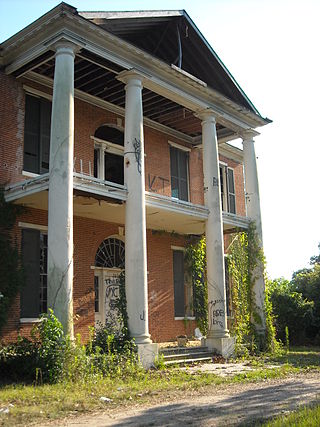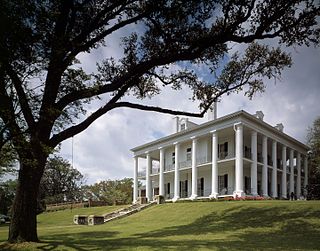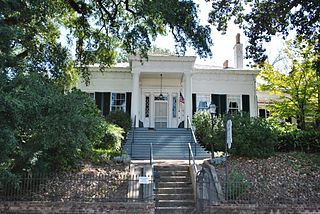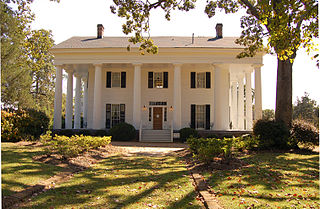
Longwood, also known as Nutt's Folly, is a historic antebellum octagonal mansion located at 140 Lower Woodville Road in Natchez, Mississippi, United States. Built in part by enslaved people, the mansion is on the U.S. National Register of Historic Places, and is a National Historic Landmark. Longwood is the largest octagonal house in the United States.

Arlington is a historic Federal style house and outbuildings in Natchez, Mississippi. The 55-acre (22 ha) property, which includes three contributing buildings, was listed on the National Register of Historic Places in 1973. It was further declared a National Historic Landmark in 1974. Following a fire that destroyed much of the main house, it was placed on Mississippi's 10 most endangered historic places for 2009 by the Mississippi Heritage Trust.

The Commercial Bank and Banker's House is an unusual combination building, housing both a bank premises and the principal banker's residence, at 206 Main Street and 107 Canal Street in Natchez, Mississippi. Built-in 1833, it is a remarkably high-quality and well-preserved example of Greek Revival architecture. It was designated a National Historic Landmark in 1974. The bank portion of the building, used for a time by a Christian Science congregation, is presently vacant, while the house portion is a private residence. Both the buildings have carved limestone used extensively, columns lintels, window sills, and the entire facia are all carved limestone with the walls being 20" thick brick construction with scored plaster to have the appearance of large limestone blocks.

Dunleith is an antebellum mansion at 84 Homochitto Street in Natchez, Mississippi. Built about 1855, it is Mississippi's only surviving example of a plantation house with a fully encircling colonnade of Greek Revival columns, a form once seen much more frequently than today. Now an inn and conference center, it was designated a National Historic Landmark in 1974. Currently the original horse stable serves as a fine dining establishment with a traditional English pub in the lower levels of the structure

The House on Ellicott's Hill, also known as Connelly's Tavern, James Moore House, or Gilreath's Hill, is a historic house museum at 211 North Canal Street in Natchez, Mississippi. Built in 1798, it is the oldest surviving building in Natchez from its early territorial period. It was declared a National Historic Landmark in 1974 and a Mississippi Landmark in 2001.

Melrose is a 15,000 square feet (1,400 m2) mansion, located in Natchez, Mississippi, that is said to reflect "perfection" in its Greek Revival design. The 80-acre (320,000 m2) estate is now part of Natchez National Historical Park and is open to the public by guided tours. The house is furnished for the period just before the Civil War. Melrose was declared a National Historic Landmark in 1974.

Monmouth is a historic antebellum home located at 1358 John A. Quitman Boulevard in Natchez, Mississippi on a 26-acre (11 ha) lot. It was built in 1818 by John Hankinson, and renovated about 1853 by John A. Quitman, a former Governor of Mississippi and well-known figure in the Mexican–American War. It is one of Natchez's grandest Greek Revival mansions. It was declared a Mississippi Landmark in 1986 and a National Historic Landmark in 1988. It is now a small luxury hotel.

Rosalie Mansion is a historic pre-Civil War mansion and historic house museum in Natchez, Mississippi. Built in 1823, it was a major influence on Antebellum architecture in the greater region, inspiring many of Natchez's grand Greek Revival mansions. During the American Civil War, it served as U.S. Army headquarters for the Natchez area from July 1863 on. It was designated a National Historic Landmark in 1989.

Stanton Hall, also known as Belfast, is an Antebellum Classical Revival mansion at 401 High Street in Natchez, Mississippi. Built in the 1850s, it is one of the most opulent antebellum mansions to survive in the southeastern United States. It is now operated as a historic house museum by the Pilgrimage Garden Club. The house was declared a National Historic Landmark in 1974 and a Mississippi Landmark in 1995.

Natchez On-Top-of-the-Hill Historic District is a historic district in Natchez, Mississippi that was listed on the National Register of Historic Places in 1979.
A Mississippi Landmark is a building officially nominated by the Mississippi Department of Archives and History and approved by each county's chancery clerk. The Mississippi Landmark designation is the highest form of recognition bestowed on properties by the state of Mississippi, and designated properties are protected from changes that may alter the property's historic character. Currently there are 890 designated landmarks in the state. Mississippi Landmarks are spread out between eighty-one of Mississippi's eighty-two counties; only Issaquena County has no such landmarks.

"Green Leaves", also known as the Koontz House or the Beltzhoover House, is a Greek Revival mansion in Natchez, Mississippi, completed in 1838 by Edward P. Fourniquet, a French lawyer who built other structures in the area. It was purchased by George Washington Koontz, a local banker in 1849 and has been owned by his descendants ever since. It was listed on the National Register of Historic Places (NRHP) in 1979.

The Burn, a house built in 1834, is the oldest documented Greek Revival residence in Natchez, Mississippi. It was built on a knoll to the north of the old town area of Natchez. It was listed on the National Register of Historic Places in 1979.

Brandon Hall is a Greek Revival architecture style house built in 1856 in Washington, Mississippi, United States. It was listed on the National Register of Historic Places in 1980.

The U.S. Custom House, also known as the Old Post Office and Custom House, is a historic government building at 423 Canal Street in New Orleans, Louisiana. It was designated a National Historic Landmark, receiving this designation in 1974 and noted for its Egyptian Revival columns. Construction on the building, designed to house multiple federal offices and store goods, began in 1848 and didn't finish until 1881 due to redesigns and the American Civil War. The U.S. Customs offices have been located there since the late 19th century.

Ardoyne Plantation House is located on Highway 311 in Schriever, Louisiana, just northwest of Houma, Louisiana. It was built 1894 and added to the National Register of Historic Places on November 1, 1982.

Antebellum architecture is the neoclassical architectural style characteristic of the 19th-century Southern United States, especially the Deep South, from after the birth of the United States with the American Revolution, to the start of the American Civil War. Antebellum architecture is especially characterized by Georgian, Neo-classical, and Greek Revival style homes and mansions. These plantation houses were built in the southern American states during roughly the thirty years before the American Civil War; approximately between the 1830s to 1860s.

The United States Courthouse, previously known as Institute Hall, Opera Hall, and Memorial Hall, is a building in Natchez, Mississippi that was initially constructed from 1851 to 1853, for use as an educational building. It has served a variety of public purposes in the intervening years. It was listed on the National Register of Historic Places in 1979. In 2007, it was rededicated as a courthouse of the United States District Court for the Southern District of Mississippi.

Lansdowne is a historic mansion that is listed on the National Register of Historic Places in Natchez, Adams County, Mississippi. It was originally built as the owner's residence on the 727-acre, antebellum, Lansdowne Plantation. The mansion and 120 acres are still owned and occupied by the descendants of the builder, who open it periodically for tours.

The Manse is a historic house in Natchez, Mississippi. It has been listed on the National Register of Historic Places since March 7, 1979.
























